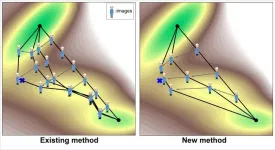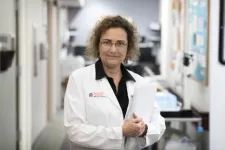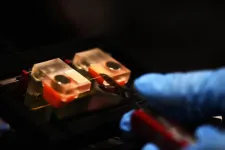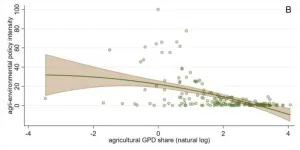(Press-News.org) Academics are proposing a new and improved way to help researchers discover when consciousness emerges in human infancy.
When over the course of development do humans become conscious? When the seventeenth-century French philosopher René Descartes was asked about infant consciousness by his critics, he eventually suggested that infants might have thoughts, albeit ones that are simpler than those of adults. Hundreds of years later, the issue of when human beings become conscious is a question which remains a challenge for psychologists and philosophers alike.
But now, in response to a recent article in Trends in Cognitive Sciences, two academics from the University of Birmingham have suggested an improved way to help scientists and researchers identify when babies become conscious.
In a Letter to the Editor, also published in Trends in Cognitive Sciences, Dr Henry Taylor, Associate Professor of Philosophy, and Andrew Bremner, Professor of Developmental Psychology, have explored a new approach which is being proposed, that involves identifying markers of consciousness in adults, and then measuring when babies start to exhibit larger numbers of these in development.
Dr Taylor says: “For example, imagine that in adults, we know that a certain very specific behaviour, or a specific pattern of brain activation always comes along with consciousness. Then, if we can identify when this behaviour or brain activation arises in babies, we have good reason to think that this is when consciousness emerges in babies. Behaviours and brain activations like this are what we call ‘markers’ of consciousness.”
This kind of approach is desperately needed since babies (unlike adults) cannot tell you what they are conscious of. Professor Bremner said: “It is really hard to establish when babies become conscious. This is mostly because infants can’t report their experiences and, as most parents will know, can be rather uncooperative particularly when it comes to experimental tasks. As we can’t just ask babies when they become conscious, the best approach is to try to identify a broad range of markers of consciousness, which appear in early development and late development, and then group them together, this could help us identify when consciousness emerges.”
In the recent article the researchers (Prof. Tim Bayne and colleagues) suggested four specific markers of consciousness, some of which are present in the late stages of gestation, and others which are found in early infancy. Based on this, the study argues that consciousness emerges early (from the last prenatal trimester).
But Professor Bremner and Dr Taylor say that this ignores other markers of consciousness. Previous research has identified a separate cluster of markers. These include:
• Pointing (bringing a social partner’s attention to an object and checking).
• Intentional control (intentional means-end coordination of actions - e.g., pulling a support to retrieve a distal object).
• Explicit memory (deferred imitation of actions).
Dr Taylor said: “One of the complicated issues is that it does not look like all the markers point to the same age for the emergence of consciousness. The ones mentioned by Bayne and colleagues suggest somewhere between the third trimester of pregnancy and early infancy, but other markers suggest the age might be around one year old. In fact, at the really extreme end, some markers only emerge at around 3-4 years. Because there are so many different markers of consciousness which appear in early and late development it is extremely hard to come to a conclusion.”
Professor Bremner concluded: “We propose that a broad approach to markers, including those that emerge in early and late stage, is needed. We also recommend that a range of developmental models of the onset of consciousness should be considered. For instance, it may be that some markers emerge in one cluster in early development, with others in a later cluster. As well as this there may be a continuous and gradual emergence of certain markers stretching over gestation and throughout early life.
“We think that by clustering this broad selection of markers, we may finally be able to answer the question which has given us pause for thought for thousands of years. But it’s important to bear in mind that the answer may not be a simple one!”Academics are proposing a new and improved way to help researchers discover when consciousness emerges in human infancy.
When over the course of development do humans become conscious? When the seventeenth-century French philosopher René Descartes was asked about infant consciousness by his critics, he eventually suggested that infants might have thoughts, albeit ones that are simpler than those of adults. Hundreds of years later, the issue of when human beings become conscious is a question which remains a challenge for psychologists and philosophers alike.
But now, in response to a recent article in Trends in Cognitive Sciences, two academics from the University of Birmingham have suggested an improved way to help scientists and researchers identify when babies become conscious.
In a Letter to the Editor, also published in Trends in Cognitive Sciences, Dr Henry Taylor, Associate Professor of Philosophy, and Andrew Bremner, Professor of Developmental Psychology, have explored a new approach which is being proposed, that involves identifying markers of consciousness in adults, and then measuring when babies start to exhibit larger numbers of these in development.
Dr Taylor says: “For example, imagine that in adults, we know that a certain very specific behaviour, or a specific pattern of brain activation always comes along with consciousness. Then, if we can identify when this behaviour or brain activation arises in babies, we have good reason to think that this is when consciousness emerges in babies. Behaviours and brain activations like this are what we call ‘markers’ of consciousness.”
This kind of approach is desperately needed since babies (unlike adults) cannot tell you what they are conscious of. Professor Bremner said: “It is really hard to establish when babies become conscious. This is mostly because infants can’t report their experiences and, as most parents will know, can be rather uncooperative particularly when it comes to experimental tasks. As we can’t just ask babies when they become conscious, the best approach is to try to identify a broad range of markers of consciousness, which appear in early development and late development, and then group them together, this could help us identify when consciousness emerges.”
In the recent article the researchers (Prof. Tim Bayne and colleagues) suggested four specific markers of consciousness, some of which are present in the late stages of gestation, and others which are found in early infancy. Based on this, the study argues that consciousness emerges early (from the last prenatal trimester).
But Professor Bremner and Dr Taylor say that this ignores other markers of consciousness. Previous research has identified a separate cluster of markers. These include:
• Pointing (bringing a social partner’s attention to an object and checking).
• Intentional control (intentional means-end coordination of actions - e.g., pulling a support to retrieve a distal object).
• Explicit memory (deferred imitation of actions).
Dr Taylor said: “One of the complicated issues is that it does not look like all the markers point to the same age for the emergence of consciousness. The ones mentioned by Bayne and colleagues suggest somewhere between the third trimester of pregnancy and early infancy, but other markers suggest the age might be around one year old. In fact, at the really extreme end, some markers only emerge at around 3-4 years. Because there are so many different markers of consciousness which appear in early and late development it is extremely hard to come to a conclusion.”
Professor Bremner concluded: “We propose that a broad approach to markers, including those that emerge in early and late stage, is needed. We also recommend that a range of developmental models of the onset of consciousness should be considered. For instance, it may be that some markers emerge in one cluster in early development, with others in a later cluster. As well as this there may be a continuous and gradual emergence of certain markers stretching over gestation and throughout early life.
“We think that by clustering this broad selection of markers, we may finally be able to answer the question which has given us pause for thought for thousands of years. But it’s important to bear in mind that the answer may not be a simple one!”
ENDS
An embargoed copy of the article is available on request.
For more information, please contact Ellie Hail, Communications Manager, University of Birmingham at e.hail@bham.ac.uk or alternatively on +44 (0)7966 311 409. You can also contact the Press Office out of hours on +44 (0)121 414 2772.
Notes to editors
The University of Birmingham is ranked amongst the world’s top 100 institutions. Its work brings people from across the world to Birmingham, including researchers, teachers and more than 8,000 international students from over 150 countries. END
Researchers propose a new way to identify when babies become conscious
2024-03-22
ELSE PRESS RELEASES FROM THIS DATE:
A reliable and efficient computational method for finding transition states in chemical reactions
2024-03-22
A computational method for finding transition states in chemical reactions, greatly reducing computational costs with high reliability, has been devised. Compared to the most widely used existing method, the present method reduces the total computational cost by approximately 50 to 70%. The development, available on GitHub, is poised to accelerate advancements in material science, making the exploration of chemical reactions more accessible and efficient. This could lead to faster scientific discoveries and technological innovations.
In chemical reactions, substances ...
Multiple unsafe sleep practices found in most sudden infant deaths
2024-03-22
There were multiple unsafe sleep practices at play in more than three-quarters of Sudden Unexpected Infant Deaths reported in 23 jurisdictions between 2011 and 2020, a new study reveals. The researchers say the findings underscore the need for more comprehensive safe-sleep education for new parents, including from healthcare providers.
Of 7,595 infant deaths reviewed, almost 60% of the infants were sharing a sleep surface, such as a bed, when they died. This practice is strongly discouraged by sleep experts, who warn that a parent or other bed partner could unintentionally ...
MD Anderson’s Institute for Data Science in Oncology announces appointment of inaugural IDSO Affiliates
2024-03-22
HOUSTON ― The Institute for Data Science in Oncology (IDSO) at The University of Texas MD Anderson Cancer Center today announced the appointment of its inaugural cohort of IDSO Affiliates. These 33 talented scientists, clinicians and staff bring diverse expertise to help IDSO leadership and focus area co-leads advance collaborative data science projects and align the institute’s efforts with MD Anderson’s mission to end cancer.
“We are proud to welcome these exceptional individuals to the growing IDSO community, and we look forward ...
B4C@TiB2 core–shell structural units show outstanding toughening effect for Al2O3 ceramics
2024-03-22
Toughening has always been an important research direction of structure ceramics. The addition of secondary phases to the ceramic matrix to prepare composite ceramics is an effective toughening pathway in the field of structure ceramics. Both phase-type and microstructure of the secondary phases play a decisive role in the toughening effect of the ceramic matrix. Being different from the conventional independent phase as the secondary phase, B4C@TiB2 core–shell structural unit has been purposely designed as an innovative kind of secondary phase to toughen the Al2O3 ceramic matrix, providing a new concept for the toughening studies of structural ceramics.
A ...
Messenger RNAs with multiple “tails” could lead to more effective therapeutics
2024-03-22
Messenger RNA (mRNA) made its big leap into the public limelight during the pandemic, thanks to its cornerstone role in several COVID-19 vaccines. But mRNAs, which are genetic sequences that instruct the body to produce proteins, are also being developed as a new class of drugs. For mRNAs to have broad therapeutic uses, however, the molecules will need to last longer in the body than those that make up the COVID vaccines.
Researchers from the Broad Institute of MIT and Harvard and MIT have engineered a ...
3D images reveal link between crack complexity and material toughness
2024-03-22
The last time you dropped a favorite mug or sat on your glasses, you may have been too preoccupied to take much notice of the intricate pattern of cracks that appeared in the broken object. But capturing the formation of such patterns is the specialty of John Kolinski and his team at the Laboratory of Engineering Mechanics of Soft Interfaces (EMSI) in EPFL’s School of Engineering. They aim to understand how cracks propagate in brittle solids, which is essential for developing and testing safe and cost-effective composite materials for use in construction, sports, and aerospace engineering.
But traditional mechanics approaches to analyzing crack formation assume ...
Decommissioned offshore structures could offer only limited ecological benefits
2024-03-22
Decommissioned offshore structures offer limited long-term ecological benefits if they are simply left in the ocean to serve as artificial reefs, a new study suggests.
The research, published in the journal Nature Sustainability, saw researchers carrying out a comprehensive analysis of existing studies into the environmental impacts of marine artificial structures – including oil and gas platforms and offshore wind farms – all over the world.
It highlighted that such installations can offer some ecological benefits – including increasing the diversity and abundance of fish species – in areas where the ...
All countries’ agri-environmental policies at a glance
2024-03-22
There can be no analysis without data. In this spirit, researchers from the University of Bonn and the Swiss Federal Institution of Technology (ETH) Zurich have published a database containing over 6,000 agri-environmental policies, thus enabling their peers as well as policymakers and businesses to seek answers to all manner of different questions. The researchers have used two examples to demonstrate how this can be done: how a country’s economic development is linked to its adoption of agri-environmental policies and how such policies impact soil erosion. Their study has now been published in “Nature Food.” Embargo: Don´t publish before March 22, ...
Bees need food up to a month earlier than provided by recommended pollinator plants
2024-03-22
Embargoed until 08:00 AM GMT / 04:00 AM ET Friday 22 March 2024
Bees need food up to a month earlier than provided by recommended pollinator plants
Plant species which are recommended as ‘pollinator friendly’ in Europe begin flowering up to a month too late for bees, resulting in low colony survival and low production of queens.
This is the first time that research has quantified the decline in colony survival and queen production due to a shortage of early season food.
Enhancing ...
Discovery of a hidden quantum critical point in two-dimensional superconductors
2024-03-22
Weak fluctuations in superconductivity1, a precursor phenomenon to superconductivity, have been successfully detected by a research group of Tokyo Institute of Technology (Tokyo Tech). This breakthrough was achieved by measuring the thermoelectric effect2 in superconductors over a wide range of magnetic fields and over a wide range of temperatures from much higher than the superconducting transition temperature to very low temperatures near absolute zero. This revealed the full picture of fluctuations in superconductivity ...





